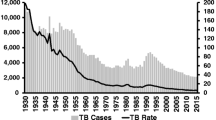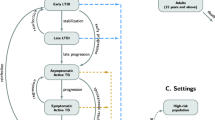Abstract
In spite of being the pioneer-leader of research into epidemiology and prevention of tuberculosis among low-income countries, India has the highest population-based burden of tuberculosis among all nations. Children with latent tuberculosis are the pool from which adult pulmonary tuberculosis emerges many years later. In the absence of primary prevention of infection by BCG, sociologic/behavioral interventions must be applied to reduce air-borne transmission. In addition to maximizing passive surveillance of adult disease, pediatric tuberculosis must also be brought under surveillance. Those with latent tuberculosis must be detected and treated to remove them from the pool. Epidemiologically, the realistic monitoring method of tuberculosis control trajectory is documenting progressive reduction of the short incubation period pediatric disease through surveillance, and not the reduction of long incubation period adult pulmonary tuberculosis. Application of scientific tools for the detection and management of pediatric tuberculosis infection — latent and active — holds the key to effective tuberculosis control.
Similar content being viewed by others
References
World Health Organization. Global Tuberculosis Report 2013, Available from: http://www.who.int/tb/publications/global_report/en/. Accessed May 3, 2014.
Tuberculosis prevention trial, Madras. Trial of BCG vaccines for prevention of tuberculosis in South India. Bull WHO. 1979;57:819–27.
Tuberculosis prevention trial, Madras. Trial of BCG vaccines in south India for tuberculosis prevention. Indian J Med Res. 1980;72:1–74.
John TJ, Babu PG, Jayakumari HM, Simoes EAF. Prevalence of HIV infection in risk groups in Tamilnadu, India. Lancet. 1987;1:160–1.
Jain NK. Drug resistance in India. A tragedy in the making. Indian J Tubercul. 1992;92:145–8.
Khatri GR. National Tuberculosis Control Program. J Indian Med Assoc. 1996;94:370–5.
John TJ. Tuberculosis control, without protection from BCG. Indian Pediatr. 2000;37:9–18.
Dowdle WR. The principles of disease elimination and eradication. Bull WHO: 1998;76: 23–5.
John TJ, John SM. Paradigm shift for tuberculosis control in high prevalence countries. Trop Med Internat Health. 2009;14:1428–30.
Kamat SR, Dawson SJY, Devadatta S. A controlled study of the influence of segregation of tuberculosis patients for one year on the attack rate of tuberculosis in close family contacts in south India. Bull WHO. 1966;34:577–632.
Directorate General of Health Services, Government of India, New Delhi. World TB day 2013. Available from: http://www.tbcindia.nic.in/pdfs/tb%20india%202013.pdf Accessed March 29, 2014.
Dasgupta PR, Jain MK, John TJ. Government response to HIV/AIDS in India. AIDS. 1994;8:S83–90.
Author information
Authors and Affiliations
Corresponding author
Additional information
This write-up is based on a lecture delivered by Prof. T Jacob John for the IAP Golden Jubilee CME in November 2013 at New Delhi, India.
Rights and permissions
About this article
Cite this article
John, T.J. Tuberculosis control in India: Why are we failing?. Indian Pediatr 51, 523–527 (2014). https://doi.org/10.1007/s13312-014-0440-x
Published:
Issue Date:
DOI: https://doi.org/10.1007/s13312-014-0440-x




